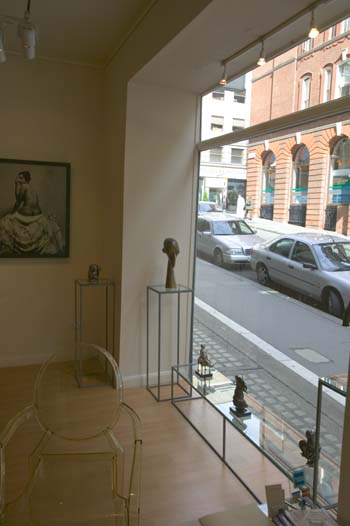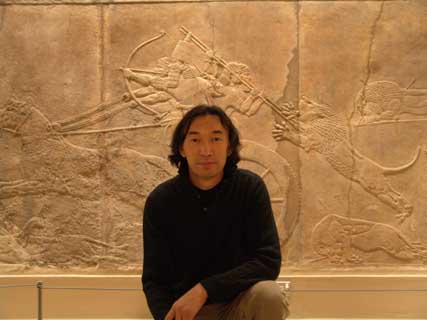 home
about
artists
exhibitions press
contact
purchase
home
about
artists
exhibitions press
contact
purchase |
||||||||||||||||||||||||||||
|
DASHI NAMDAKOV - PRESS
"The New-York Times" Magazine published an article about Dashi's
current exhibition at Tibet House, NYC By SABRINA TAVERNISE Published: April 26, 2004 The president of Russia, Vladimir Putin, has one. His former chief of staff has two. The Russian billionaire Roman Abramovich has two, as does the Russian supermodel Irina Pantaeva. They are sculptures of shamans, nomads and warriors by an artist from a Siberian village so remote that a visitor would have to fly six hours east of Moscow to reac h it. They have recently become very popular among the Russian elite. So popular, in fact, that Mr. Putin, speaking German, took Chancellor Gerhard Schröder on a visit to the artist's work during Mr. Schröder's visit to Russia last fall."I joke that he was my translator," the artist, Dashi Namdakov, said of Mr. Putin. Fresh from his success among Russian millionaires, Mr. Namdakov, 37, accompanied by a manager who used to work with Russian rock groups, has come to New York. On April 15, he opened an exhibit of sculpture and other art at Tibet House on West 15th Street. It is not entirely clear how Mr. Namdakov's works, priced at $2,000 to $40,000, will be received here. On the day after the opening, the number of visitors who came to the show in two afternoon hours barely qualified as a trickle. A staff member at Tibet House, a non-profit cultural center headed by Robert Thurman, a professor of Buddhist studies at Columbia University, acknowledged that buyers had been slow in coming. But in an interview the day after the opening, Mr. Namdakov - wearing his great- grandfather's Buddhist prayer beads over a zippered sweater and striped pants from a popular Moscow clothing store - appeared content to sit and sketch, and muse at how far he had come. "From my village to New York. I do not have words to describe the distance." It is difficult to overstate the remoteness of his native region, called Buryatia, located just north of Mongolia, where the shamanism- and Buddhism-practicing inhabitants are descendants of Mongol tribes. Mr. Namdakov's hometown, Ukurik, is a two-and-a-half-hour drive from the nearest city, and is far closer to Beijing than to Moscow. But it is the remoteness and the culture that goes with it that inspires many aspects of his work. The sculptures, cast mostly in bronze, draw heavily on the area's shamanism and Buddhism and on its nomadic past. Whimsical warriors from ancient Mongol tribes sit on horses. Grinning lamas bang on kettle drums. Apple-shaped wrestlers squat like frogs. For Russians who own his work, Mr. Namdakov is an artist they can call their own. Of the new work displayed in recent years, "his stands out the most," said Alexander S. Voloshin, Mr. Putin's former chief of staff. But clever marketing by his manager, Konstantin Khankhalaev, who is in town with Mr. Namdakov this month, has helped. A short film about Mr. Namdakov - more music video than artistic display - was available for viewing on a laptop computer in the New York exhibit. The artist was shown galloping on horseback across the steppe. At the exhibit this month, Mr. Khankhalaev referred to popular sculptures as "hits," and the hardbound, glossy-paged art catalogues were printed with English translations. New Yorkers who visited the show praised it. "The craftsmanship was brilliant," said Beatrix Ost, a Manhattan artist, who bought two sculptures for her outdoor patio. "I thought, this is the work of a very ripe person in his 60's. But he is only in his 30's. It's fresh and modern. "In traditional Asian art, Ost said, "you see all these figures from temples and gods, and you say, 'Oh, this is Tibet, this is India.' But he is not quite from anywhere. "His work, she said, "is eastern. But it's also 'Star Wars.'" Mr. Namdakov, the sixth of eight children, grew up with art and religion. His father carved and painted Buddhist altars. His great-grandfather made the ritual pilgrimage on foot from Buryatia to Tibet. But by age 7, Mr. Namdakov had to leave the comfort and culture of his home to attend a school in another town. It would be the worst experience of his life. Accommodations were austere, with poorly heated rooms, threadbare uniforms, and unvaried meals. Teachers, he said, stole food. Also, prejudice against children who were not ethnically Russian ran deep, he said. In one particularly humiliating punishment, he and other Buryat boys were forced to stand in a hallway in their underwear after running from Russian boys who tried to fight. "School was horrible," he said. "Before age 7, I had a world of family members and spirits. That world is now emerging again." During the former Soviet Union's perestroika period, Mr. Namdakov attended a fine-arts college. He held his first show, in the Siberian city of Irkutsk, in 2000. Local magnates, newly rich from Russia's large-scale property giveaway, eagerly bought his work, he said. His life now is comfortable. He drives a used Audi. He has moved to Moscow with his wife and children. He can afford to travel between studios in Buryatia and Moscow. Mr. Namdakov is content to stay in Russia, but his art, he says, is not. New York may yet prove receptive. Last week , a gallery on Greene Street asked to represent him. In Tibet House two weeks ago, he sat
and sketched. Sometimes he thought out loud. "If someone had told me
years ago that I'd be putting on an exhibit in New York, I never
would have believed it." Also: The International Herald
Tribune, 27 April, 2004
Online magazine, issue no.7 ANCIENT SPIRITS' WHISPER
Each of his art work is a unique and complete vision. They seem so perfect and refined to the smallest detail it is hard to accept they are made of hard metal. Proportions, spirituality, finest shapes of a human body- all come from the artist's deep understanding of the human nature. The features are so true and realistic as if coming directly from the Nature. Not surprisingly, almost all the works by sculptor Dashi Namdakov were sold out within days after his exhibition opening last July. Now 33-year-old, this young Master comes from Russian Siberia, the Land of Buryat Mongols. Last year he presented his first exhibition in Moscow, and soon after his works were highly praised at the Art Expo in New York. Many of his works already went to private collectors from all over the world. "All my works are rooted in my childhood," says the sculptor. He was born in a small Siberian village lost amidst forests on the Russian Mongolian border. Only about 60 families live in the village and there is no school or post office.
As a child Dashi grew in the wilderness of Siberian taiga forest, surrounded by the traditional culture of Buryats. His father was a skilled craftsman able to do blacksmithing and jewellery, wood carving and even making carpets. All his eight children inherited the talent of their father, but only Dashi has become a professional artist. At age of seven Dashi was send to a boarding school where he was the only Buryat. "It was a hard experience," says the artist. Life in an hostile and alien environment only stressed his passion for the culture of his own people. He dreamt of going after school to a prestigious art college in Moscow, but there was no way for a provincial boy, even if talented, to enter reputed art schools without recommendations. After two times failure he gave up, and went instead to the Arts College of Siberia from which he graduated with honours completing a four years program within two. Dashi feels at ease in many forms of art doing graphics, painting, sculpture. But he likes most to work with metals like bronze,- "the most visually expressive" material.
"Each thing or idea has its own inner logic which dictates the form of expression. I think that by understanding and following this logic one can create the wholeness out of details," says the sculptor. That is why almost all his works are full of life, harmony and spontaneity of the real life. Even the works representing the power and might like that of a warrior or shaman betray the sign of inner weakness. In Asian arts the perfection of forms holds a special meaning as it reveals and reflects the inner harmony.
Blacksmiths who also often served as jewellers were called "people with god blessed mind" for their skills of creating perfectly shaped but yet, functional items and utensils. They commanded such a respect that they enjoyed a very special privilege of not standing up when facing a noble, for their skills were valued more than that of any noble. This understanding of the inner beauty of things and the talent are the gifts Dashi Namdakov inherited from his ancestors to express the spirits of his land and forefathers. Newsweek International,
June 21, 2004 Namdakov's world of celestial creatures, spirits and mythical animals is currently on view at New York's Tibet House and travels to Germany, Switzerland and Austria this summer. Some critics argue that his pieces hark back to shamans, nomads, warriors, goddesses and animals from a bygone age, which the sculptor does not deny. "Maybe these works existed before," he says, acknowledging his influences: the ancient arts of Iran, India, Egypt, Japan, Scythia and Babylon. Still, Namdakov's use of distortion modernizes these classical symbols: by recreating them as asymmetrical, mostly elongated figurines, he brings out a Picassoesque beauty that is anything but traditional. Vibhuti Patel
This is London, The Weekly Magazine for International Visitors, Friday 5 November 2004, Issue 2509, Friday 19 November 2004, Issue 2511
The show of Dashi Namdakov, a sculptor and a graphic artist from Buryatia (Russia), is being held at the Hay Hill Gallery in London until 20 December.
Dashi's pieces of art have already become a synonym for contemporary ethnic ritual sculpture. Fulfilled mostly in realistic manner, they are at the same time significantly hyperbolic. Perfect plasticity and exalted emotionality of his 'warriors' and 'guardians' have made their creator a classic of modern sculpture.The variety of materials Dashi works with is impressive: bronze, silver, gold, mammoth tusk, horsehair. The works 'Full Moon' and 'Raven' are a genre mixture of sculpture and tapestry and have no precedent in recent art history. In Dashi's sculpture one can find traditional images of Central Asia steppe civilization - warriors and beauties, lamas and shamans, totemic animals and mythological creatures. In 2003 Dashi was awarded the Silver Medal of the Russian Academy of Arts. The exhibition held at Tibet House in New York earlier this year gained the artist a worldwide fame. The Hay Hill Gallery is located at 11B Hay Hill, Mayfair, W1. The exhibition is open Monday to Friday 11.00 to 18.00, and Saturday from 11.00 to 17.00.
The Atlanta Journal-Constitution,
29 September 2004 Dashi Namdakov now lives in Moscow, where the well-heeled, including Vladimir Putin, snap up his sculptures. But the heart of his art lies miles and light-years from the western urbanity of contemporary Russia. Dashi, as he is called, grew up in an isolated Siberian village near the Mongolian border, a community where Buddhism and shamanism intermingle. Although the 37-year-old artist graduated from art school, his real mentors were his family. His father, a craftsman who carved Buddhas and altar tables, educated his hand. His grandfather, who regaled him with stories of his Buryat ancestors, descended from Genghis Khan, sparked his imagination. He had plenty of time to nurture that imagination, first during a seven-year childhood illness finally cured by a shaman, and then in difficult years as an ethnic outsider in a Russian boarding school. Add to that the influence of ancient Middle Eastern and Asian art, and you have the recipe for Dashi's strange and skilful sculpture in bronze, silver, wood and mammoth tusk. "Bowman" is a soldier in samurai armour who stretches in a gravity-defying posture only Jet Li could duplicate. His Asian features — flat face, high cheekbones, almond eyes, Fu Manchu beard — and grace are typical of Dashi's sculptures. In contrast to "Bowman's" masculine heft, Dashi's females are elongated, boneless, otherworldly creatures — goddesses and passive sex objects. "Evening" is a Mongolian Modigliani with a youthful face and an old woman's breasts. The long-haired maiden winds like a pretzel into a posture worthy of the Kama Sutra. Though exotic to the Western eye (and perhaps a bit kitschy), the sculptures strike a chord as well. Dashi's characters would be comfortable in the "Lord of the Rings" or "Star Wars" sagas. An aura of myth and the supernatural pervades his work, even the animals. His shamans, in their elaborate headdresses of tusks and horse skulls, exude a force that might give Darth Vader pause. Most of Dashi's sculptures are incarnations of power — physical, sexual, spiritual. But not all. He depicts soldiers who are weary old men — squat, necklace, potbellied — rather than fearless warriors. "Horseman," for example, brings to mind the beleaguered Don Quixote. Dashi is more prone to descend into kitsch in his female figures. For example "Princess" — a figurine in silver, bone and precious stones — is cute and cloying. Even then, Dashi's craftsmanship, his command of his materials and his attention to detail are unimpeachable.
|
||||||||||||||||||||||||||||
|
|
E-mail: info@hayhillgallery.com |
|||||||||||||||||||||||||||



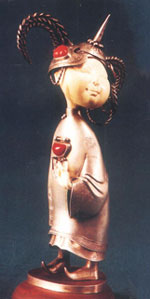

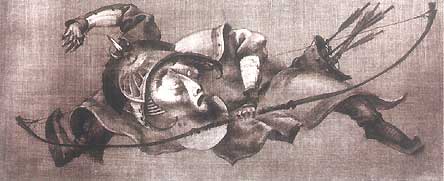


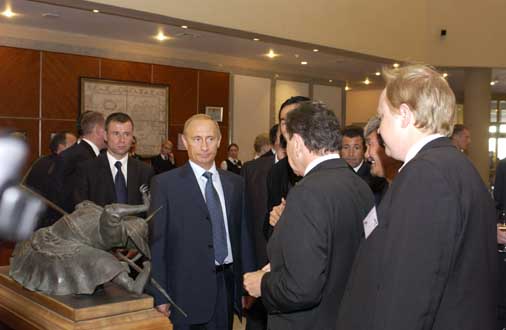
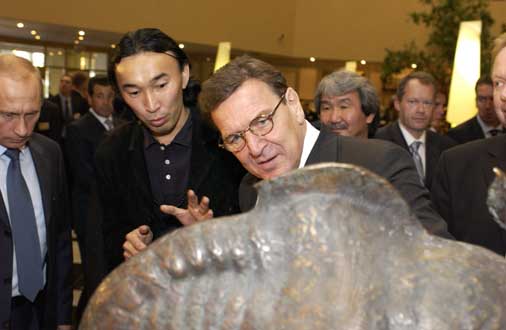
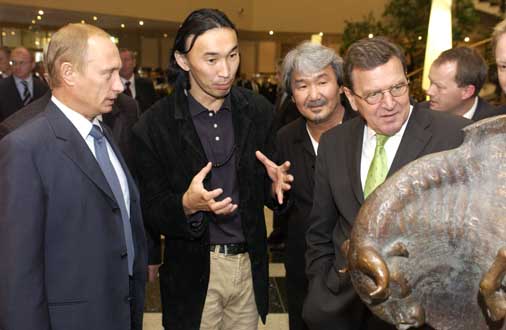

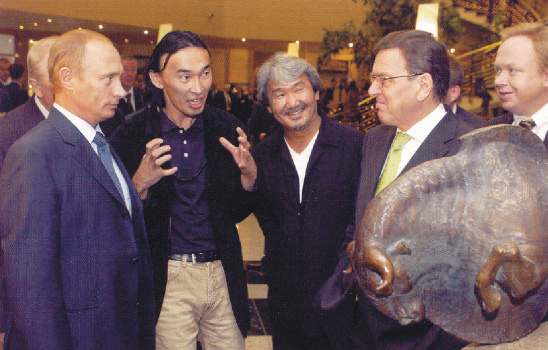



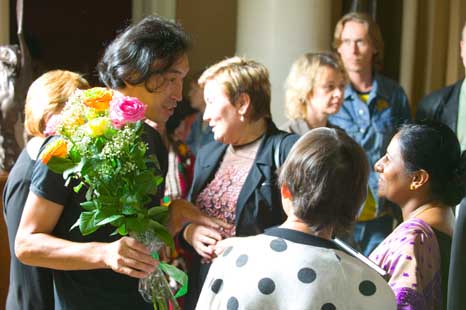
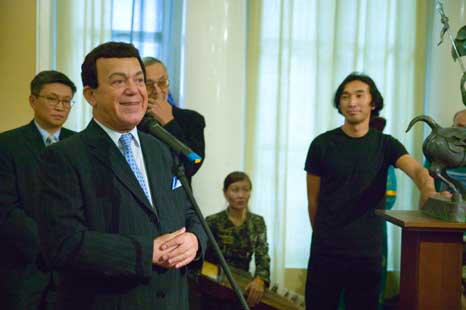
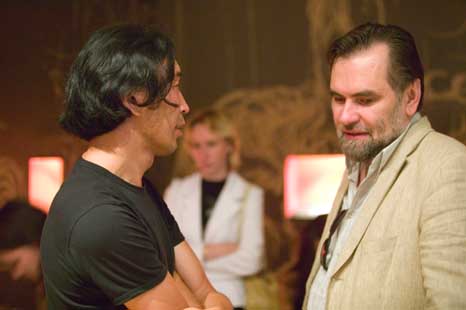
 Dashi's
artworks are kept at the State Hermitage, the State Museum of
Oriental Art, the Russian Ethnographic Museum, the Russian Museum of
Modern Art, in private collections of Russian President V. Putin,
President of Tatarstan M.Shaimiev, Moscow Mayor Yu. Luzhkov,
Governor of Chukotsk autonomous region R. Abramovich and other
representatives of Russian political and business elite, as well as
in private collections in Germany, France, Belgium, Switzerland,
Finland, Japan, the USA, and Taiwan. Dashi's works have been
acquired by German Chancellor Gerhard Schroeder, country music star
Willie Nelson, and actress Uma Thurman.
Dashi's
artworks are kept at the State Hermitage, the State Museum of
Oriental Art, the Russian Ethnographic Museum, the Russian Museum of
Modern Art, in private collections of Russian President V. Putin,
President of Tatarstan M.Shaimiev, Moscow Mayor Yu. Luzhkov,
Governor of Chukotsk autonomous region R. Abramovich and other
representatives of Russian political and business elite, as well as
in private collections in Germany, France, Belgium, Switzerland,
Finland, Japan, the USA, and Taiwan. Dashi's works have been
acquired by German Chancellor Gerhard Schroeder, country music star
Willie Nelson, and actress Uma Thurman.
